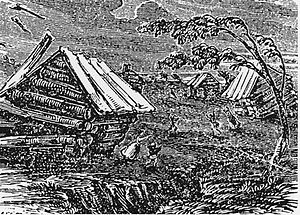Estimates are that the quake raised and lowered parts of the Mississippi River Valley by as much as 15 feet. At one point along the river, in what is now northwest Tennessee, the quake energy was so strong that it caused the river to run backward, in part creating huge ripples in what is now Reelfoot Lake.
 Also along the river, huge swells, some up to 15 feet, destroyed boats and wharves and otherwise overwhelmed riverbank settlements.
Also along the river, huge swells, some up to 15 feet, destroyed boats and wharves and otherwise overwhelmed riverbank settlements.
Many landslides occurred the region. People who traveled in the area after the quake reported deep cracks in the ground and tall trees bent over or shattered.
The area of land affected by the initial earthquake and more than 2,000 aftershocks felt between December 1811 and February 1812 is estimated at 600,000 square miles. The New Madrid fault system is made up of part of what is now Arkansas, Illinois, Kentucky, Missouri, and Tennessee. People living in frontier settlements in many of those areas reported toppled chimneys and buildings.
The initial earthquake, on December 16, 1811, is estimated to have registered 8.6 on the Richter Scale. A handful of the aftershocks are estimated to have registered 8.0 or greater.
Damage from the initial quake was reported in Washington, D.C., in the form of broken sidewalks. Church bells in Boston were said to have rung of their own accord. Other major population centers having people reporting damage included New York City and Charleston, S.C. Reports of the ground shaking, sometimes as long as three minutes at a stretch, were widespread along the Eastern Seaboard.
Two massive aftershocks were reported in subsequent months, one in January 1812 and one in February 1812. The February aftershock leveled the settlement of New Madrid and caused major damage in nearby St. Louis.
These earthquakes took place long before the advent of the Richter scale and some years before the affected areas were widely settled. In the years since these massive quakes, shakings of smaller magnitude have been relatively regular.